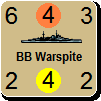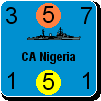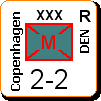warspite1
Posts: 41353
Joined: 2/2/2008
From: England
Status: offline

|
Here is the write-up for the first of the Japanese "Midway" carriers.
[4322 Akagi - by Robert Jenkins]
.B Engine(s) output: 133,000 hp
.B Top Speed: 31 knots
.B Main armament: 6 x 8-inch (203mm), 12 x 4.7-inch (120mm) guns
.B Aircraft: 91 (Operational maximum 72)
.B Displacement (full load): 42,750 tons
.B Thickest armour: 10-inch (belt)
.P The carrier Akagi began life as a battlecruiser, having been designed as
such for the Imperial Japanese Navy (IJN) during the First World War. She was one
of four planned ships of the Amagi-class.
.P Construction work on the first of the class was not begun until 1920, and
thanks to the 1922 Washington Naval Treaty, none of the class were destined to be
completed as intended. The latter two ships were cancelled, but the first two
vessels, Amagi and Akagi, were earmarked for conversion to aircraft carriers. In
the end only Akagi was completed; Amagi being destroyed in an earthquake while
under construction.
.P Akagi was only finally completed in 1927. She was then reconstructed in the
late thirties and the technical details above are as at the time of the attack on
Pearl Harbor.
.P Her modernisation saw the addition of a small island, unusually located on her
port side. Along with Hiryu, these were the only carriers ever completed with an
island situated on the left.
.P Akagi`s practical aircraft operating capacity rose to seventy-two thanks to an
enlargement of both her hangars. These hangars were serviced by three lifts. As
was standard with Japanese carriers throughout the war, there was no catapult
fitted to assist launching of aircraft, although a total of nine arrester wires
provided the necessary stopping power when landing.
.P Protection was minimal. Akagi benefited from a ten-inch belt, courtesy of her
original battlecruiser design, but her horizontal armour was limited to just a
thin armoured deck, which provided little protection for her hangars, magazines
or her aviation fuel stores.
.P Defensive weaponry was also sub-optimal, with six eight-inch guns positioned
aft within casemates. Her anti-aircraft (AA) armament consisted of six twin 4-
inch and fourteen twin 25mm close-range guns.
.P Akagi possessed good top speed following an increase in output to 133,000 hp,
and a switch to an oil-burning propulsion system. However, whilst a useful
aircraft carrier, capable of operating a sensible number of aircraft, she was all
too vulnerable to attack from either enemy aircraft or plunging shell fire.
.P Akagi means Red Castle in English and she was named after an extinct Volcano.
.P In late November 1941, Akagi was Vice-Admiral Nagumo`s flagship. From the
bridge of this carrier, Nagumo would lead the attack on Pearl Harbor; the attack
that brought the United States (US) into the war.
.P The US was the enemy that Japan considered the greatest threat to their
territorial expansion plans in Asia. In July 1942, the US President had cranked
up economic pressure on Japan in a bid to persuade her Government to withdraw
their forces from China. The result was that Japan, a country heavily reliant
upon imports, would soon face a choice; cease the war in China or seize by force
the raw materials (especially oil) that she was now being denied. Japan chose
war...
.P The Hawaiian Operation was designed to deliver a knock-out blow to the US
Pacific Fleet at its Pearl Harbor base, with the principal targets being the
Pacific Fleet carriers. The architect of the Pearl Harbor attack, Admiral
Yamamoto, was fully aware of the industrial potential of the US and knew that
Japan would find defeating her in a protracted war a very difficult task. In
presenting his plan therefore he made it clear that all he could hope to achieve
was to effectively neutralise the threat from the US for up to eighteen months.
During that time Japan would need to conquer the various territories in Asia and
the Pacific that would give her a) the resources she so coveted, and b) provide
her with a defensive ring that would protect her from US counter-attack in the
future.
.P The fleet tasked with carrying out the attack was the 1st Air Fleet (the Kido
Butai) containing: the 1st Carrier Division (CarDiv), Akagi and Kaga; the 2nd
CarDiv, Hiryu and Soryu; and the 5th CarDiv, Shokaku and Zuikaku. Escort was
provided by the 1st Destroyer Flotilla, which contained the light cruiser Abukama
and nine destroyers. In Support, were the battleships Hiei and Kirishima of the
3rd Battleship Squadron, and the 8th Cruiser Squadron containing the heavy
cruisers Chikuma and Tone. Completing the naval force were eight tankers and two
further destroyers that were earmarked for the shelling of Midway Island. For
this operation the IJN also deployed submarines, although their role in the
operation was negligible (see Submarine Counter 4452).
.P The six carriers carried over four hundred aircraft between them; a mixture of
Mitsubishi A6M2 "Zero" fighters, Aichi D3A "Val" dive bombers and Nakajima B5N
"Kate" torpedo bombers. These highly effective aircraft were flown by the elite
aircrews of the IJN which had been training for war for many months while the
rulers of Japan debated their options.
.P Nagumo`s fleet sailed from Hitokappu Bay on the 26th November and began the
long voyage eastward toward the Hawaiian Islands. They sailed under conditions of
complete radio silence, via a northern route, in order to avoid detection. On the
2nd December Nagumo received a signal that he was to open a secret envelope. This
envelope confirmed that the attack on Pearl Harbor would take place on the 7th
December.
.P In the early morning of the 7th, when Nagumo`s fleet were about two hundred
and twenty miles from Hawaii, the order was given for the carriers to turn into
the wind and for the first wave to begin take-off. This first wave consisted of
one hundred and eighty-three aircraft and the first of these took off at around
0600hrs. This wave was made up of: eighty-nine Kates; forty armed with torpedoes
and forty-nine with bombs; fifty-one Val dive-bombers, and forty-three Zero
fighters. While still off Hawaii, the aircraft were actually detected by US radar
operators, but they were mistaken for a flight of B-17 bomber aircraft that were
due to arrive in Hawaii from the US that morning.
.P Meanwhile, Japanese embassy officials in Washington were having trouble in
translating a fourteen page document sent from Tokyo. This document, which
announced their declaration of war on the US should have been presented to the US
Secretary of State, Cordell Hull, prior to the attack. Because of the translation
problems, the attack on Pearl Harbor took place without a formal declaration of
war.
.P Back in Hawaii, the Japanese strike aircraft headed for the naval base, where
their targets were to be, in order of importance: carriers, battleships, cruisers
and other vessels. The 1st Attack Group, led by Lt-Cdr Fuchida, began the first
of their attacks at 0755hrs. The torpedo armed Kates from the 1st and 2nd Torpedo
Attack Units were the first on the scene. Twenty-four aircraft flew down on the
ships on battleship row, closely followed by the similarly armed Kates of the 3rd
and 4th Torpedo Attack Units which descended onto ships based to the north of
Ford Island. Almost at once the bomb-armed Kates of the 1st, 2nd, 3rd and 4th
Attack units swooped down on battleship row too.
.P The Val dive-bombers of the 2nd Attack Group and Zeros of the 3rd Attack Group
were tasked with, respectively, bombing and strafing the aircraft, hangars and
airfield at the Hickham air base and also the Naval Air Station at Wheelers Field
on Ford Island. In some cases the US aircraft had been tightly parked together in
order to keep them safe from potential sabotage and this made them more
vulnerable to the Japanese attacks. The Zeros were also tasked with attacking the
seaplane base at Kaneohe Bay and the airfields at Bellows Field and Ewa.
.P Almost as soon as the first wave had left the scene, the second wave appeared
at 0840hrs. This wave consisted of one hundred and sixty-eight aircraft, again
split into three attacking groups, and made-up as follows: 1st Attack Group,
fifty-four bomb-armed Kates; 2nd Attack Group, seventy-eight bomb-armed Vals; and
3rd Attack Group, thirty-six Zero fighters. The Vals flew to Battleship Row to
attack any ships missed by the first wave and the Kates were given the job of
attacking the airfields. As before, the Zeros job was to strafe the air bases.
.P When the aircraft of the first wave returned to the carriers, Nagumo was urged
to launch a third strike. However, the Japanese admiral was aware by now that the
US carriers were not at Pearl and for all he knew they were searching for his
fleet. Nagumo also believed that his flyers had done all that could be done and
given these two facts, there was no point courting danger for no reason.
.P After recovering the second wave, the Kido Butai departed the scene, leaving
behind them a scene of devastation. The once proud battlefleet was mostly resting
on the shallow harbour floor: neither Arizona nor Oklahoma would ever return to
action, while California, Maryland, Nevada, Pennsylvania, Tennessee and West
Virginia would need major repair and reconstruction work. Of the other combat
vessels at anchor that morning, the cruisers Helena, Honolulu and Raleigh also
required major reconstruction, as did the destroyers Shaw, Cassin, Downes and
Helm.
.P The cost to the Japanese was a mere twenty-nine aircraft and six minisubs (see
Submarine Counter 4452) and a total of 185 servicemen killed. But for the US, the
cost was far higher. 3,581 civilians and navy and air force personnel were
casualties, of which 2,403 were killed. One hundred and sixty-nine aircraft were
shot out of the sky or were destroyed on the ground.
.P However, despite this, the attack was far from the success that Yamamoto was
hoping for, and which Japan needed, in order to justify the decision to go to
war. The attack failed to achieve its primary aim of sinking the three US Pacific
Fleet carriers which, by chance, were away from Pearl Harbor at the time. In
addition, many of the vital installations dotted around the harbour, such as the
fuel storage tanks and workshops, emerged completely unscathed from the attack.
US Vengeance against four of the six carriers of the Kido Butai would not be long
in coming....
.P After the Hawaiian Operation, Akagi returned to Japan, where she remained
until early January. She was then sent to the Central Pacific stronghold of Truk
in the Caroline Islands, and from there, on the 17th of that month, she and the
other ships of the 1st Air Fleet (less the 2nd CarDiv) were sent to support the
invasion of the islands of New Britain and New Ireland in the Bismarck
Archipelego (see Transport Counter 4446). This operation went without problem and
Akagi the returned to Truk at the end of the month.
.P The 1st Air Fleet were next ordered to sea in response to American carrier
raids against the Marshalls and the Gilbert Islands (see Katori). The Japanese
failed to find the US Navy ships and so no engagement resulted from this sortie.
.P In mid-February the 1st Air Fleet were tasked with launching an air raid on
the northern Australian port of Darwin (see Soryu) which took place between the
15th and 19th February. Then, with barely time for replenishment, Akagi was sent
south of Java at the end of the month to assist operations to conquer that
island. The 1st Air Fleet were tasked with stopping Allied shipping from fleeing
Java and to stop any reinforcement of the island (see Chikuma).
.P After this successful operation, Akagi returned to Celebes. She was not there
long before the ships of the 1st Air Fleet were ordered to the Indian Ocean and
their next operation, beginning at the end of March; the attack on the Royal Navy
at their base in Ceylon. The attack was only partially successful as the British
fleet had been sent to Addu Atoll in the Maldives, but one old aircraft carrier,
two cruisers, two destroyers and two other warships were sunk (see Hiryu).
.P On the way back from the Indian Ocean, when east of the island of Formosa, the
1st Air Fleet received a report about the presence of US carriers about 700 miles
from Japan. One of the carriers was Hornet that had just launched the B-25
bombers that bombed Tokyo (the Doolittle Raid). Nagumo`s ships joined in the
search for the US ships but without success.
.P After almost six months of near uninterrupted action, Akagi then went into a
period of rest and refit ahead of her next - and last - operation; MI. For this
operation Akagi was once again the flagship of Vice-Admiral Nagumo. MI was
designed to bring the American aircraft carriers to a battle in which they would
be destroyed. The bait to lure them was an invasion of the island of Midway,
1,150 miles northwest of Honolulu. As it turned out, the battle was a disaster
for the IJN, in which they lost all four fleet carriers, including Akagi (see
Kaga).
.P Akagi`s end came at the hand of Dauntless dive-bombers, flown from the carrier
USS Enterprise. Akagi could not have been more vulnerable; she had aircraft on
her deck fully armed and fuelled and awaiting take-off. A bomb hit her aft and
fell amongst these aircraft. A second bomb hit one of her lifts, smashing it into
the hangar deck below. Fires immediately broke out and were soon uncontrollable.
Nagumo transferred his flag to the cruiser Nagara and Akagi`s Captain Aoki, was
also saved. Three hundred officers and men were lost. Akagi burned through the
night before being scuttled at 0520hrs the following morning.
< Message edited by warspite1 -- 1/6/2010 7:38:15 PM >
_____________________________
England expects that every man will do his duty. Horatio Nelson October 1805  |
 Printable Version
Printable Version
 Just copy/paste into Word/Notepad or something like that and magnify. Unfortunately that makes the text even longer
Just copy/paste into Word/Notepad or something like that and magnify. Unfortunately that makes the text even longer  well it *seems* longer anyway.
well it *seems* longer anyway. 










 Archipelago!
Archipelago!  .
.  .
. 

 New Messages
New Messages No New Messages
No New Messages Hot Topic w/ New Messages
Hot Topic w/ New Messages Hot Topic w/o New Messages
Hot Topic w/o New Messages Locked w/ New Messages
Locked w/ New Messages Locked w/o New Messages
Locked w/o New Messages Post New Thread
Post New Thread